Microsoft Surface Pro 3: Hands On, Display & Performance Preview
by Anand Lal Shimpi on May 20, 2014 3:25 PM EST- Posted in
- Tablets
- Microsoft
- Mobile
- Surface
- Surface Pro 3

Earlier today Microsoft announced its 3rd generation Surface Pro device, aptly named the Surface Pro 3. This is the first Surface model to deviate from the 10.6" 16:9 form factor of all four previous devices (Surface Pro, Surface RT, Surface Pro 2, Surface 2) and instead standardizes on a 12" 3:2 form factor. The resulting device is also substantially thinner, now at 9.1mm (0.36"). Surface Pro 3 is now somewhere between the thickness of Surface 2 and Surface RT.
The original Surface Pro featured a kickstand that could stay open at a fixed 22-degree angle. Surface Pro 2 added another stop (40 degrees) to the kickstand to allow for more flexible, laptop-like operation. Surface Pro 3 features the same initial 22-degree stop, however it can be opened to any angle beyond that (up to 150-degrees) using a new high friction hinge. The hinge opens with little effort to its first stop, anything beyond that requires additional force. It's enough to feel secure, but not too little that the hinge loses its position. It's unclear how this new hinge will hold up over time but I suspect Microsoft put a good amount of testing into it.
With the device width comes a new type cover with a larger trackpad and secondary magnetic strip. The second magnetic strip can provide a second attach point to the Surface Pro 3, allowing the cover to be a more stable base when used in laptop mode. In practice the new hinge with more stable type cover creates a much more laptop-like base, which definitely comes in handy when typing on your lap. In my brief time with the review unit I still found it to be less stable than a laptop, but it's a far closer approximation to the laptop experience than it ever has been before.
The new trackpad is substantially larger horizontally and features a new lower friction surface. The trackpad is actually a clickpad with left/right buttons activated by pushing down on the lower left/right corners of the clickpad itself. Using the integrated trackpad on previous Surface covers was an exercise in madness that got mildly better last generation.
Right off the bat the new clickpad on the 3rd generation type cover is a lot better, but it's still not in laptop-territory as far as experience goes. I'll need to spend more time with it to see if it's truly past the point of being frustrating to use.
There's a new battery powered pen for Surface Pro 3. You lose some pressure sensitivity (256 levels vs 1024), but there are new features that Microsoft hopes will make up for it. I haven't spent much time with the new pen at all so I'll save commentary on it for the full review.
The new design features the same sized battery as previous Surface models. I'm guessing we'll see a reduction in battery life given the new, presumably higher power display, but I'll find out for sure over the coming days.
Microsoft also added 802.11ac support to the new Surface Pro courtesy of Marvell's Avastar-AC solution (88W8897 perhaps?).
And yes, connected standby is supported.
| Microsoft Surface Pro Comparison | |||||||||
| Surface Pro 3 | Surface Pro 2 | Surface Pro | |||||||
| Dimensions | 11.5 x 7.93 x 0.36" | 10.81 x 6.81 x 0.53" | 10.81 x 6.81 x 0.53" | ||||||
| Display | 12-inch 2160 x 1440 | 10.6-inch 1920 x 1080 w/ Improved Color Accuracy | 10.6-inch 1920 x 1080 PLS | ||||||
| Weight | 1.76 lbs | 2.0 lbs | 2.0 lbs | ||||||
| Processor | Core i5-4300U with HD4400 Graphics (15W Haswell ULT) | Core i5-4200U with HD4400 Graphics (15W Haswell ULT) | Core i5-3317U with HD4000 Graphics (17W Ivy Bridge) | ||||||
| Cameras | 5MP/5MP (front/rear) | 1.2MP/1.2MP (front/rear) | 1.2MP/1.2MP (front/rear) | ||||||
| Connectivity | 802.11ac WiFi | WiFi | WiFi | ||||||
| Memory | 4GB or 8GB LPDDR3 | 4GB or 8GB LPDDR3 | 4GB | ||||||
| Storage | 64, 128, 256 or 512GB |
64 or 128GB (4GB RAM) 256GB or 512GB (8GB RAM) |
64GB or 128GB | ||||||
| Battery | 42.0 Wh | 42.0 Wh | 42.0 Wh | ||||||
| Starting Price | $799 | $899 | $799 | ||||||
Display
With Surface Pro 3, Microsoft finally accepts that while 16:9 may be a great aspect ratio for watching movies but it's not optimal for a multi-purpose tablet. The tablet features a 12" 2160 x 1440 display (RGB stripe, not RGBW/PenTile), which ends up being a 3:2 aspect ratio. The difference is immediately noticeable in notebook-style use. While the Surface Pro 2 was never quite all that comfortable to use as a laptop, Surface Pro 3's display makes it substantially more laptop-like. There doesn't appear to be a substantial impact to tablet use either with the larger display. Particularly with Windows 8.1's split screen mode, the larger display ends up working extremely well. I'll talk about the new hinge a bit more in the usability section but the aspect ratio alone is a huge step forward.
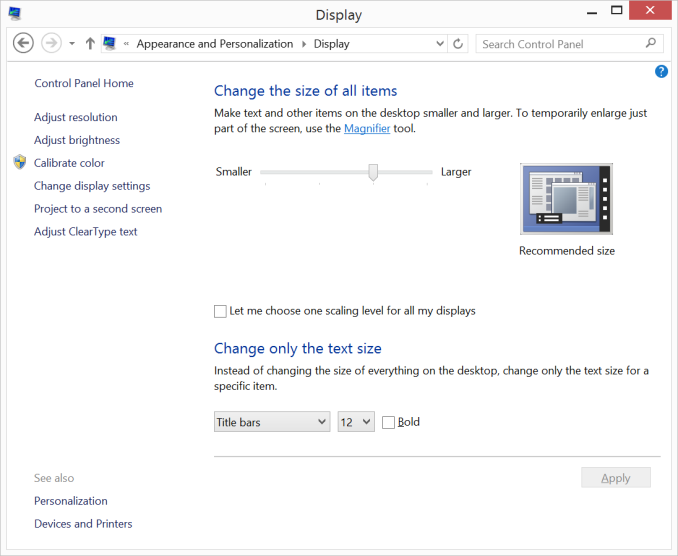
Default Scaling on Surface Pro 3
Color accuracy is improved out of the box as well. The original Surface Pro had a display capable of being quite accurate, if calibrated, but out of the box it was a bit of a mess. Microsoft slowly improved out of box calibration over the years, eventually culminating in what we have today with Surface Pro 3.

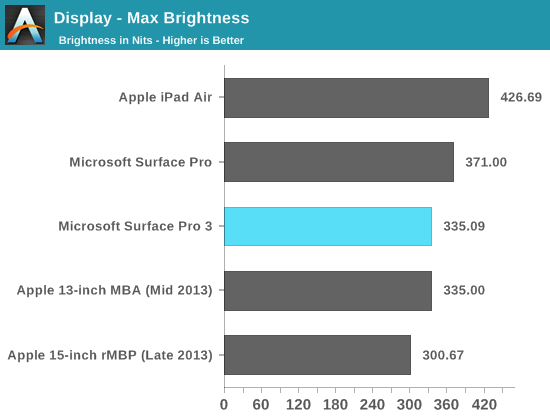
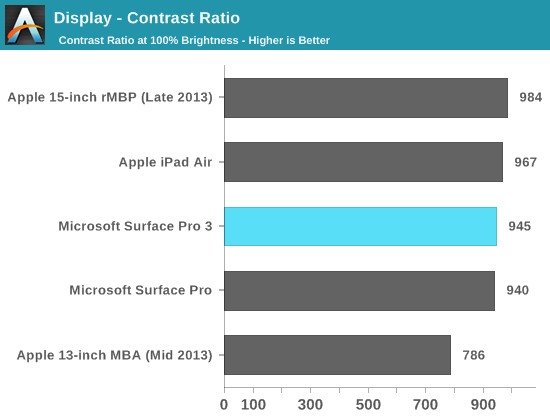
Max brightness drops a bit compared to Surface Pro 2, likely due to the Pro 3 having 50% more pixels to light. Black levels at max brightness are pretty good, thanks in part to Microsoft's optically bonded LCD/cover glass stack. Contrast ratio remains competitive with previous designs.
Grayscale accuracy is the biggest issue with the new display, green levels are just way too high:
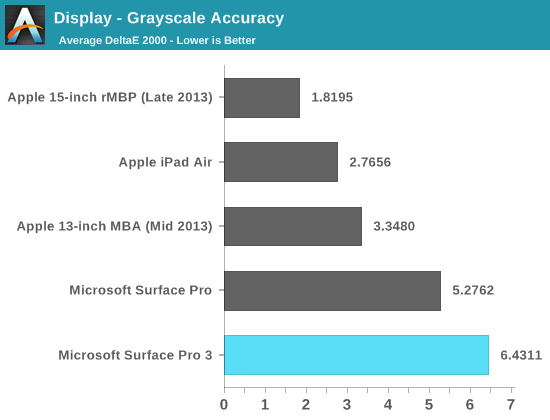
Our basic sRGB gamut test paints a great picture for Surface Pro 3. Full saturation color reproduction is excellent:
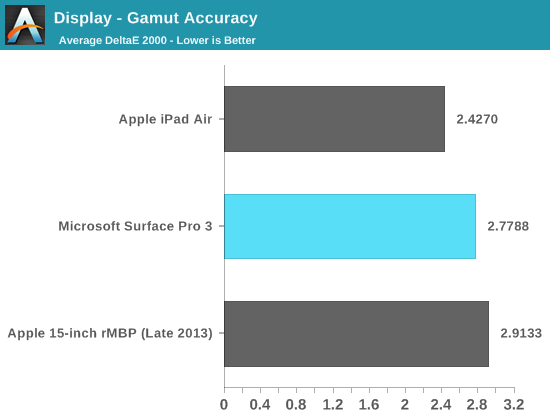
The saturation sweep also looks solid:
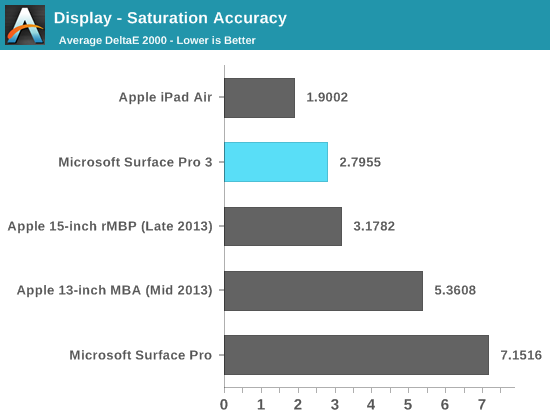
Unfortunately Surface Pro 3 doesn't do so well on our GMB color checker test. Part of the problem is its performance in the grayscale swatches included in this test:

Overall the display is a big improvement over the previous Surface Pro generations, but it's still behind iPad Air territory in terms of color reproduction which is disappointing. Given Microsoft's focus on Surface Pro 3 as an image editing tool, I would've hoped for class leading performance across the board.
Performance
Surface Pro 3 still uses a 15W Haswell ULT SoC. My review sample uses a Core i5-4300U (a speed bump of SP2's original 4200U), although there are also Core i3 and i7 options as well. In the case of the i5-4300U we're talking about a dual-core/4 thread Haswell part with a 3MB L3 cache. The CPU cores run at up to a 1.9GHz base frequency and 2.9GHz max turbo. The latter is quite impressive given the incredibly thin (9.1mm) Surface Pro 3 chassis. My guess is that Intel is giving Microsoft the best binned Haswell ULT parts to ensure good performance at low thermals. There are still 4GB or 8GB memory options, although my sample came with 8GB of LPDDR3.
I saw sustained speeds of 2.6GHz while running single-threaded Cinebench 11.5:
The system's internal fan was definitely audible during the Cinebench run.
On the storage front Microsoft is still using a SATA based drive. It's unfortunate that more PC makers haven't shifted to PCIe, although I suspect that'll come next year with NVMe based solutions (I hope). My review sample featured a 256GB Samsung PM851 drive, this is an OEM version of the TLC based Samsung SSD 840 EVO.
Despite featuring a thinner chassis, I measured performance improvements over both previous Surface Pros. I'll have more data in the final review but here I'm seeing a 3 - 20% increase in performance over the Surface Pro 2.
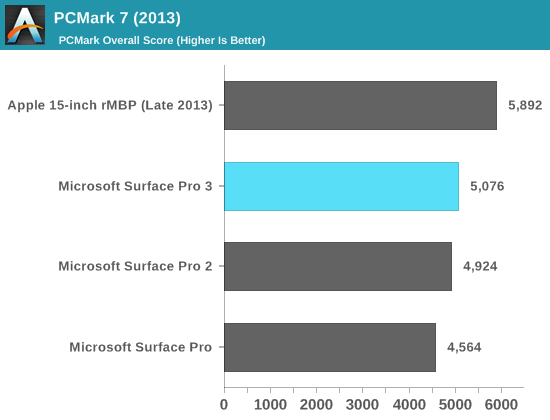

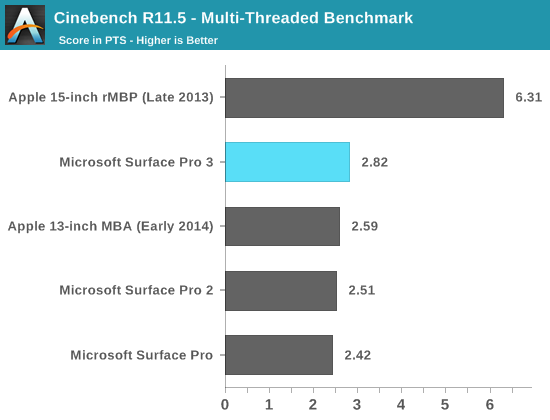
Final Words
There's a lot more work to do on Surface Pro 3, including substantial battery life testing and continued usage. If there's anything in particular you guys want to see us touch on, leave it in the comments below.


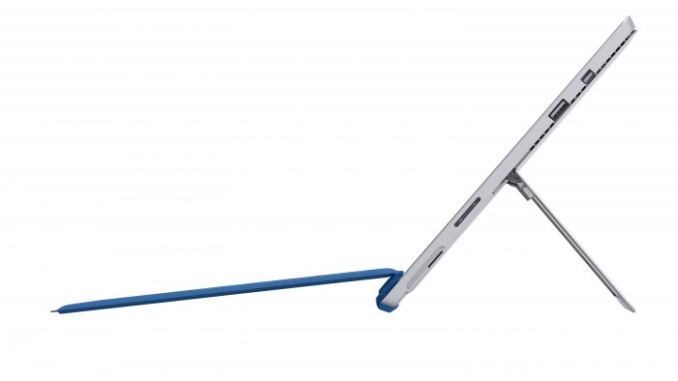
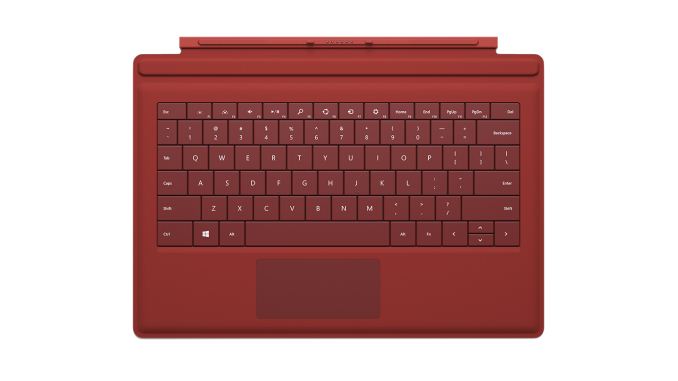
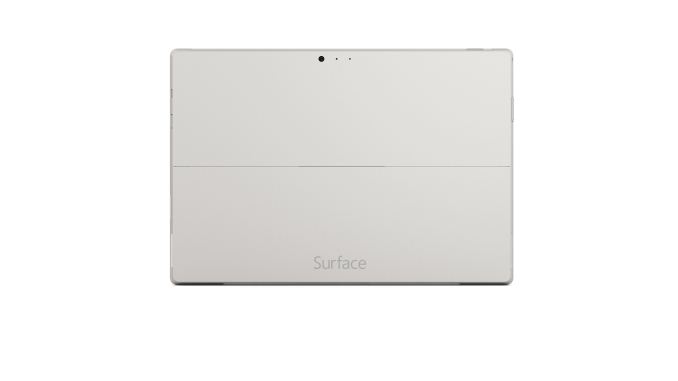
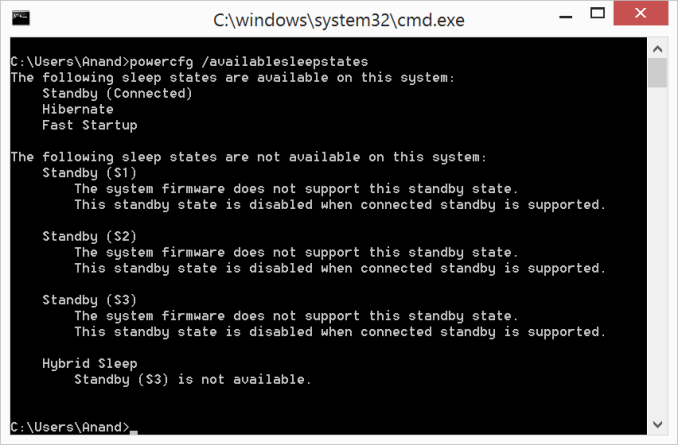
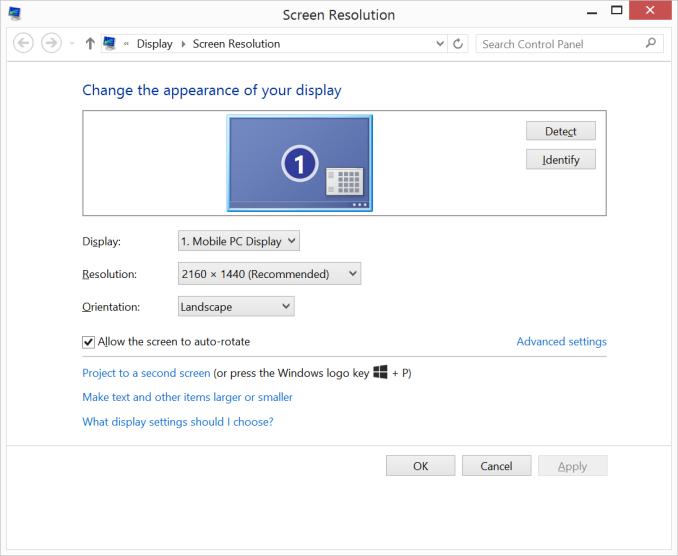



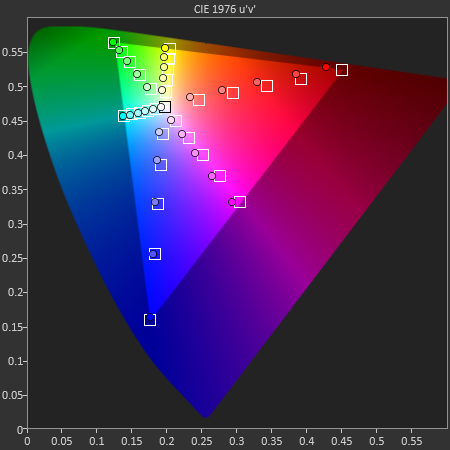


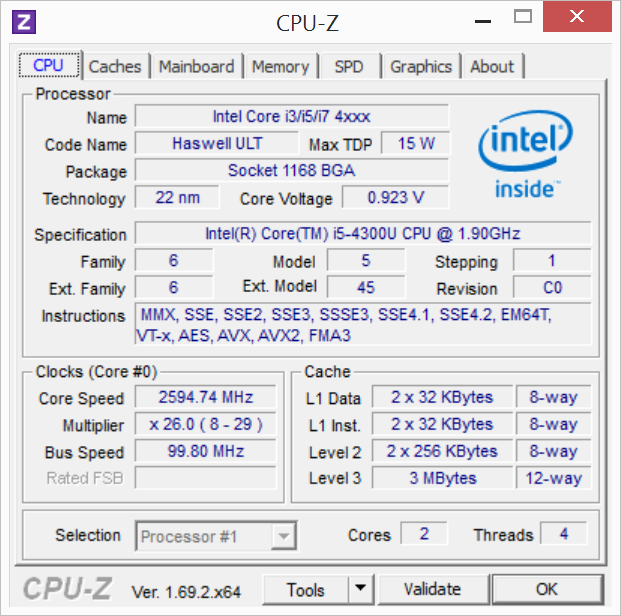
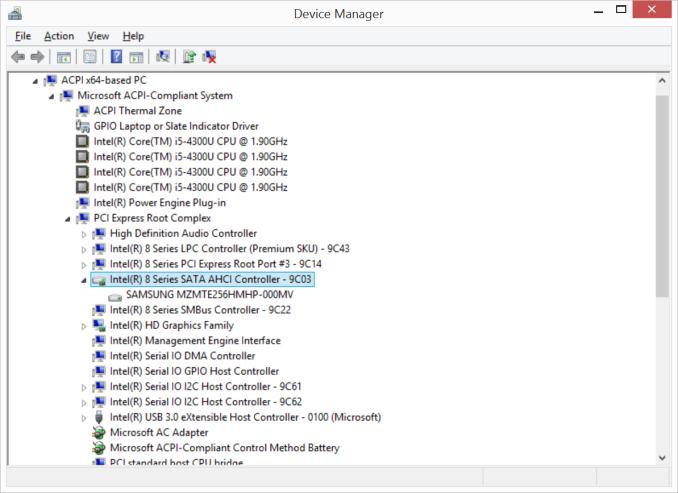








295 Comments
View All Comments
_david - Wednesday, May 21, 2014 - link
A half circle is 180 degrees. So it can swing from 0 degrees (completely "closed") up to almost completely flat against the opposite side.uhuznaa - Wednesday, May 21, 2014 - link
OK, when you start from 0 degrees this way the kickstand has not an initial 22-degree stop but an initial 112-degree stop and the friction hinge allows it to be moved further back to 150 degrees.In any case "22 degrees up to 150 degrees" when speaking of the kickstand is just plain wrong. Either it allows 112 to 150 degrees (if measured from the "closed" position with the screen facing down) or 22 to 60 degrees (if measured from a vertical position).
Drumsticks - Wednesday, May 21, 2014 - link
Not quite... Moving the kickstand 22 degrees doesn't mean the screen rotates 22 degrees. The kickstand does certainly have a 22 to 150 degree angle of rotation. It rotates from closed (zero) to twenty two, past the midway point, to almost fully open (150).You are right in that the viewing experience is not 128 degrees wide. It starts probably at about 110 degrees from fully closed and ends pretty close to probably 150-160.
So your sentiment is right but the technical saying "22-150" degrees for the kickstand is accurate. I might have misunderstood you, apologies if I did.
uhuznaa - Wednesday, May 21, 2014 - link
OK, I did misunderstand it. Thanks for the explanation. So the 22/150 degrees is the angle of the kickstand in relation to the device? I would be much more interested in the angle the Surface can be configured to sit though.modulusshift - Wednesday, May 21, 2014 - link
That's just going to be some math. At 22 degrees, it would be a tent, with line perpendicular to the table bisecting the angle, meaning the screen is leaned back 11 degrees from perpendicular, or 101 degrees. At 150 degrees, that'll be trickier... that's 30 degrees from flat back the other way, and the kickstand angle is halfway down the whole tablet, meaning it has twice as long to decline the same amount, so about half the measure angle. 15 degrees off of 180, then? 165 degrees?So friction from 101 to 165 degrees, I think. Not bad.
HaceQ - Wednesday, May 21, 2014 - link
I'd love to see a more in-depth look at how well the new pen and digitizer combo works in the Surface Pro 3 compared to the one in Surface Pro 2.The N-trig based digitizer in the Surface Pro 3 has traditionally had a pretty bad reputation when it comes to things like lag and pressure sensitivity support in drawing applications, mostly caused by what appear to be bad drivers and no wintab drivers for software that doesn't use Microsofts' Ink API.
Taking notes may be much improved in this N-trig powered device but is drawing and similar fine grained and faster use of the stylus now worse? A lot of people love the Surface Pros for digital art and a step back in this would have a huge impact on buying decisions.
HaceQ - Wednesday, May 21, 2014 - link
I'll just reply to myself to say that the N-trig solution brings a lot of benefits for drawing as well and a lot of the N-trig hate is for really old versions of the tech but since every implementation's different I'd love to hear some real life experiences.AthlonBoy - Wednesday, May 21, 2014 - link
I noticed that the new dock doesn't use the USB or DisplayPort on the Surface itself, but uses its own proprietary connector. In the few pictures I've found of it, it doesn't have enough pins to be a dumb port replicator. What kind of interface is it?errorr - Wednesday, May 21, 2014 - link
Long term I just don't know how big a market tablets will be. You see as iPad sales have leveled off and the replacement cycle is slower. The surface is ostensibly a laptop/tablet hybrid and may be the future but I don't know.On a very long term scale smart phones are the future of personal computing. The only sure thing long term is smart phones and servers.
What I mean is that people are so focused on how the capabilities of a computer are integrated with a certain input paradigm. There is no reason that should be true.
With a smartphone I'll carry around a good-enough level of compute for almost any task. If I need to interact with a bigger screen or keyboard or mouse there is no reason my phone can't drive a desktop display or tablet. Smartphones also have the benefit of ubiquitous connectivity. The real killer is also the secure identity management function a smartphone can provide. It knows who I am, who I talk to, and what I need to know and I always have it with me.
There will always be niche uses for more powerful computers but I'm not sure that matters for many people. If I need compute for anything the cloud will provide that much cheaper.
The only question is gaming. Why not eventually provide a box that will do the heavy lifting while I'm at home with the right api and output it to a screen of my choice. That is already where NV seems to be headed.
The primary driver of laptop sales is enterprise usage. However, as solutions become more SaaS focused the need to have anything but a thin client running is diminished. I don't need a laptop to interact with my Salesforce dashboard.
Truthfully I find I barely use my laptop as much more than a glorified typewriter. Sometimes I run some small data analytics stuff for personal interest (sports stats) but that is the only thing I needed it for. I moved 2 years ago and still haven't bothered to set up my desktop since I replaced it with a dedicated NAS as storage.
This is still a long way off but I already find 90% of my time is spent on my phone. Most of the world will NEVER own a laptop or a desktop in their lives. Consumer oriented compute is eventually and solely the province of the smartphone.
So I'm thinking about some sports bets and am going to spend a few bucks on an AWS instance to run some stuff I wrote in R. I did 95% of the work on my phone during smoke breaks. I don't know how much something like surface matters.
modulusshift - Wednesday, May 21, 2014 - link
Okay, yes, if you get all the technology working as you describe, there won't be as much use for tablets. But you're forecasting so far in the future that there's no point in saying anything. Beyond your point, there won't be a need for smartphones or tablets, because whenever you want to see something on a screen, your brain implant will create a screen for you to interact with virtually without it actually being there, and any content could be streamed directly from the servers.You're basically just saying that there only needs to be the cloud and an interface with it, and you prefer a smartphone to be that interface. I prefer tablets until we get to an Atrix or PadFone state, personally, because I like having the performance right there.